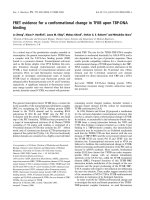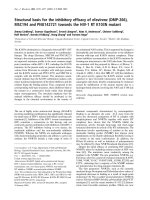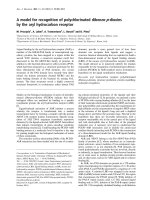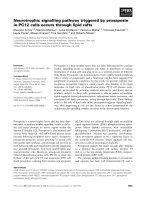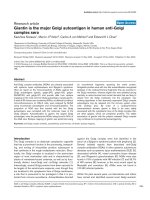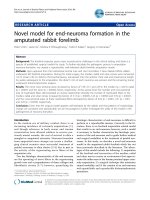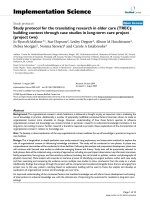Báo cáo y học: "Reproductive health for refugees by refugees in Guinea II: sexually transmitted infections" pptx
Bạn đang xem bản rút gọn của tài liệu. Xem và tải ngay bản đầy đủ của tài liệu tại đây (260.21 KB, 7 trang )
BioMed Central
Page 1 of 7
(page number not for citation purposes)
Conflict and Health
Open Access
Research
Reproductive health for refugees by refugees in Guinea II: sexually
transmitted infections
Mark I Chen*
1
, Anna von Roenne
2
, Yaya Souare
3
, Franz von Roenne
2
,
Akaco Ekirapa
1
, Natasha Howard
1
and Matthias Borchert
1
Address:
1
London School of Hygiene and Tropical Medicine, London, UK,
2
Gesellschaft für Technische Zusammenarbeit, Eschborn, Germany and
3
Reproductive Health Group, Guéckédou, Guinea
Email: Mark I Chen* - ; Anna von Roenne - ; Yaya Souare - ;
Franz von Roenne - ; Akaco Ekirapa - ; Natasha Howard - ;
Matthias Borchert -
* Corresponding author
Abstract
Background: Providing reproductive and sexual health services is an important and challenging aspect of
caring for displaced populations, and preventive and curative sexual health services may play a role in
reducing HIV transmission in complex emergencies. From 1995, the non-governmental "Reproductive
Health Group" (RHG) worked amongst refugees displaced by conflicts in Sierra Leone and Liberia (1989–
2004). RHG recruited refugee nurses and midwives to provide reproductive and sexual health services for
refugees in the Forest Region of Guinea, and trained refugee women as lay health workers. A cross-
sectional survey was conducted in 1999 to assess sexual health needs, knowledge and practices among
refugees, and the potential impact of RHG's work.
Methods: Trained interviewers administered a questionnaire on self-reported STI symptoms, and sexual
health knowledge, attitudes and practices to 445 men and 444 women selected through multistage
stratified cluster sampling. Chi-squared tests were used where appropriate. Multivariable logistic
regression with robust standard errors (to adjust for the cluster sampling design) was used to assess if
factors such as source of information about sexually transmitted infections (STIs) was associated with
better knowledge.
Results: 30% of women and 24% of men reported at least one episode of genital discharge and/or genital
ulceration within the past 12 months. Only 25% correctly named all key symptoms of STIs in both sexes.
Inappropriate beliefs (e.g. that swallowing tablets before sex, avoiding public toilets, and/or washing their
genitals after sex protected against STIs) were prevalent. Respondents citing RHG facilitators as their
information source were more likely to respond correctly about STIs; RHG facilitators were more
frequently cited than non-healthcare information sources in men who correctly named the key STI
symptoms (odds ratio (OR) = 5.2, 95% confidence interval (CI) 1.9–13.9), and in men and women who
correctly identified effective STI protection methods (OR = 2.9, 95% CI 1.5–5.8 and OR = 4.6, 95% CI
1.6–13.2 respectively).
Conclusion: Our study revealed a high prevalence of STI symptoms, and gaps in sexual health knowledge
in this displaced population. Learning about STIs from RHG health facilitators was associated with better
knowledge. RHG's model could be considered in other complex emergency settings.
Published: 23 October 2008
Conflict and Health 2008, 2:14 doi:10.1186/1752-1505-2-14
Received: 29 July 2008
Accepted: 23 October 2008
This article is available from: />© 2008 Chen et al; licensee BioMed Central Ltd.
This is an Open Access article distributed under the terms of the Creative Commons Attribution License ( />),
which permits unrestricted use, distribution, and reproduction in any medium, provided the original work is properly cited.
Conflict and Health 2008, 2:14 />Page 2 of 7
(page number not for citation purposes)
Background
Displaced populations continue to need reproductive and
sexual health services during armed conflicts, which can
last for decades [1]. The provision of reproductive and sex-
ual healthcare in populations affected by complex emer-
gencies poses a unique challenge. Behavioural changes
arising from large population movements, social disrup-
tion and the poverty and violence experienced by dis-
placed persons, may increase incidence of sexually
transmitted infections (STIs) and HIV [2,3]. Men may
have opportunistic sex or visit sex workers [4]. Women
may be raped, coerced to trade sex, or enter relationships
to secure basic survival [3,5]. However, there is evidence
that the impact of conflict on the sexual transmission of
HIV is context specific [6-9], depending on factors such as
the prevalence of STIs and HIV in the populations
involved and the adequacy of relevant refugee health serv-
ices [10]. Health programmes must thus adapt their
approaches to provide prevention and treatment services
specific to the setting [11].
There has been a lack of published epidemiological
research dealing with the implementation of sexual and
reproductive health interventions for displaced popula-
tions [2]. Here we report about a knowledge, attitude and
practice survey among Sierra Leonean and Liberian refu-
gees of reproductive age, residing in camps in Guinea,
where the "Reproductive Health Group" (RHG) had pro-
vided reproductive health services to refugees for several
years. RHG, a local non-governmental organisation, is of
special interest because they recruited nurses and mid-
wives from the refugee community itself, and seconded
them to Guinean health facilities, while trained refugee
lay women provided contraceptives and health education,
and drama groups attempted to specifically reach males
and adolescents. Details on RHG's activities and the set-
ting where they were active are described in the compan-
ion paper [12] and elsewhere [13].
The survey was conducted in 1999 and had the following
objectives:
• To assess sexual health needs, knowledge and practices
among refugees, e.g. prevalence of reported STI symp-
toms, knowledge about symptoms and prevention of
STIs, treatment seeking and protective behaviour adopted
by those experiencing STI symptoms
• To assess the potential impact of RHG's work, in terms
of increased STI knowledge and more appropriate STI-
related behaviour in RHG clients
Survey results on family planning aspects are reported in
the companion paper [12].
Methods
Details on study population, sampling strategy, survey
methodology, data entry and analysis are provided in the
companion paper [12]. In brief, a cross-sectional survey
was conducted in a representative multistage sample of
889 reproductive-age men and women refugees from 48
camps served by RHG. In addition to socio-demographic
information, survey sections of relevance here include
questions on self-reported STI symptoms, and STI-related
knowledge and behaviour. Respondents who had some
knowledge of STIs were asked to name, unprompted, STI
symptoms in men and women, and to assess a list of
measures for protecting themselves from STIs – this list
included two accepted and effective methods, and three
inappropriate but prevalent methods. They were also
asked about their main information source (e.g. health
workers, RHG facilitators, dramas, friends, family, or
media). In addition, respondents who reported genital
discharge and/or ulceration within the past 12 months
were asked about their treatment-seeking and partner
notification/protection measures.
Study outcomes were:
• correctly identifying genital discharge AND genital
ulcers in men and women as STI symptoms (key symp-
toms validated in African settings for syndromic STI man-
agement) [14]
• correctly identifying two accepted methods as effective
for protecting against STIs (staying with one faithful part-
ner, or using condoms during sexual intercourse)
• NOT agreeing that three inappropriate methods for pro-
tecting against STIs were effective (swallowing a tablet
before sexual intercourse, avoiding public toilets, or – for
women – washing their genitals after sexual intercourse)
• adopting an appropriate combination of behaviours
when having STI symptoms, namely notifying their part-
ner/s about their STI symptoms (which would facilitate
care-seeking by the partner/s), AND protecting the part-
ner/s from potential acquisition of an STI (either by
abstaining from sex, or by using a condom)
Prevalence of these outcomes was compared between
groups citing different sources of STI information and
associations tested between outcome variables and socio-
demographic and behavioural covariates. Chi-squared
tests were used where appropriate. Covariates significant
at p < 0.10 were entered into a multivariable logistic
regression model. Robust standard errors were used to
account for cluster sampling.
Conflict and Health 2008, 2:14 />Page 3 of 7
(page number not for citation purposes)
The study received ethical clearance from the Ministry of
Public Health in Guinea and the London School of
Hygiene & Tropical Medicine in the UK.
Results
The response rate exceeded 95%, and the final sample
used was 889 (445 men and 444 women). Results on
demographics are reported in the companion paper [12].
STI knowledge
Most respondents (90% of men, 92% of women) had
some knowledge of STIs (Table 1). 43% of men and 58%
of women (Chi2-test, p < 0.001) cited RHG facilitators as
their main source of STI information, while 18% of
respondents cited healthcare workers and 7% RHG drama
groups. Men indicated non-healthcare sources more fre-
quently than women (22% vs. 10%, p < 0.001; 18% vs.
9% named friends and family as their main source of STI
information, 4% vs. < 1% radio programmes or school).
Self-reported STI symptoms were common, with 30% of
women and 24% of men (p = 0.02) reporting at least one
episode of genital discharge and/or ulceration within the
past 12 months.
Figure 1 presents the results on knowledge of STI symp-
toms, showing the five STI symptoms most frequently
named by the 399 men and 410 women who had some
knowledge of STIs. Both sexes were more familiar with STI
symptoms in their own rather than the opposite sex.
While around 75% of respondents recognised penile dis-
charge as an STI symptom, only 52% of men recognised
vaginal discharge as a possible STI symptom for women.
Only 32% of men and 42% of women suggested genital
ulcers as STI symptoms in the opposite sex. Failure to rec-
ognise genital ulcers as an STI symptom in the opposite
sex meant that only a minority of those who had some
knowledge of STIs could correctly name the two key STI
symptoms of genital discharge and genital ulceration for
both sexes (24% of men and 26% of women, respec-
tively).
Table 2 (see additional file 1) presents STI prevention
findings in individuals with some knowledge of STIs.
Most respondents recognised that staying with one faith-
ful partner and using condoms were effective, and 86% of
men and 89% of women agreed with both methods.
However, almost two thirds also judged one or more inap-
propriate STI prevention beliefs (e.g. swallowing tablets
before sex, avoiding public toilets, and/or washing their
genitals after sex) to be effective; only 38% of men and
41% of women rejected all inappropriate suggestions.
STI treatment-seeking behaviour
Figure 2 presents the behaviours reported by individuals
when experiencing genital discharge and/or ulceration.
Men were more likely than women to seek care from
health facilities or to purchase medicines. Women were
more likely than men to visit a traditional healer. Men
were also more likely than women to notify their partners
or avoid sex when symptomatic. Condom use, to protect
partners when symptomatic, was infrequently reported by
either sex. Approximately 78% of men adopted the appro-
Table 1: Source of STI knowledge and prevalence of self-reported STI symptoms
Men,
N = 445
Women,
N = 444
Characteristic % (n) % (n) p-value
(Chi
2
test)
Ever heard of STIs 89.7% (399) 92.3% (410) 0.163
Most important source of information about STIs <0.001
Healthcare and RHG sources
- health workers 17.1% (76) 18.2% (81)
- RHG drama groups 7.2% (32) 6.3% (28)
- RHG health facilitators 43.4% (193) 57.7% (256)
Non-healthcare sources
- friends and family 18.2% (81) 9.5% (42)
- radio 2.7% (12) 0.2% (1)
- school 0.9% (4) 0.2% (1)
- others 0.2% (1) 0.2% (1)
Had STI symptoms in the past 12 months
- had genital discharge 21.8% (97) 26.6% (118) 0.096
- had a genital ulcer 8.8% (39) 12.4% (55) 0.079
- had either genital discharge or a genital ulcer 23.6% (105) 30.4% (135) 0.022
- had both genital discharge and a genital ulcer 7% (31) 8.6% (38) 0.375
Conflict and Health 2008, 2:14 />Page 4 of 7
(page number not for citation purposes)
priate combination of behaviours when perceiving STI
symptoms, i.e. they reportedly informed their partner/s,
and protected them from potential acquisition of the STI,
mostly by stopping sex, less frequently by using a con-
dom. This percentage was much lower in women (46%).
Outcome indicators by source of STI information
Table 3 (see additional file 2) presents the prevalence of
selected outcome indicators for men and women,
grouped by STI information source. Among respondents
who had some knowledge of STIs, correct knowledge
about STI symptoms and prevention was significantly less
frequent in those citing non-healthcare sources, while
those citing RHG facilitators as their main information
source were more likely to respond correctly. Among
those with STI symptoms, respondents citing RHG facili-
tators as their main source of knowledge were more likely
to adopt appropriate behaviours than those citing non-
healthcare sources, although this difference was not statis-
tically significant. Several outcomes remained signifi-
cantly associated with STI information source after
adjusting for potential confounding in multivariable anal-
yses. Both men and women who cited RHG facilitators
were more likely to identify effective STI protection meth-
ods (adjusted odds ratio (OR) = 2.9, 95% confidence
interval (CI) 1.5–5.8 in men, and OR = 4.6, 95% CI 1.6–
13.2 in women) after adjusting for other factors signifi-
cantly associated with this outcome (educational level
and marital status in men, and educational level and age
at first sexual intercourse in women). Respondents of
both sexes who agreed with the two accepted methods of
STI prevention were also marginally (but not signifi-
cantly) more likely to identify key STI symptoms. Men cit-
ing RHG facilitators were significantly more likely to
name the key STI symptoms (OR = 5.2, 95% CI 1.9–13.9)
when compared with those citing non-healthcare infor-
mation sources. Women citing RHG facilitators were like-
wise more likely to name the key STI symptoms, but this
association was not statistically significant (OR = 2.0, 95%
CI 0.9–4.6, p = 0.106), since levels of knowledge in
Knowledge of STI symptoms in men and women, by sex of respondentFigure 1
Knowledge of STI symptoms in men and women, by sex of respondent. The 399 men and 410 women who had ever
heard of STIs were asked to name, without prompting, STI symptoms in men and women. Results for the five STI symptoms
most frequently named are presented; we also present the proportion that name a combination of key STI symptoms in men,
in women, and in both men and women. Key symptoms were defined as penile discharge and genital ulcers/open sores in men,
and vaginal discharge and genital ulcers/open sores in women. Items where the proportions differ significantly between genders
are annotated (*** p < 0.001, ** p < 0.01, * p < 0.05).
0% 10% 20% 30% 40% 50% 60% 70% 80% 90%
- penile discharge**
- pain on passing urine***
- genital ulcers / open sores**
- blood in urine**
- genital itch
- vaginal discharge***
- dysuria***
- genital itch***
- genital ulcers / open sores***
- abdominal pain
- for Men**
-for Women**
- for both Men and Women
% of Men who named the symptom/s (N = 399)
% of Women who named the symptom/s (N = 410)
Symptoms in Men
Symptoms in Women
Key symptoms
% of sex who named the symptom/s
Conflict and Health 2008, 2:14 />Page 5 of 7
(page number not for citation purposes)
women citing non-healthcare information sources was
higher than for the men (17.8% in women vs 8.2% in
women, see Table 3). None of the sociodemographic or
behavioural factors (age, religion, educational level, time
in refugee camp, marital status and age at first sexual inter-
course) were found to be associated with better knowl-
edge about STI symptoms in either men or women.
Discussion
This survey, conducted under difficult conditions in a ref-
ugee population, highlights the necessity of good sexual
health services for refugees. The majority of those dis-
placed were sexually experienced; the prevalence of self-
reported STI symptoms was high, in line with the high
prevalence of lab-confirmed STIs in Rwandan refugees
[15]. Similarly high estimates have been reported in
reproductive-age women in non-emergency African set-
tings [16].
Most respondents had heard of STIs, but many had only a
superficial understanding. Less than 30% identified the
two key symptoms in both sexes. While genital discharge
was generally known, genital ulcers (more important in
facilitating HIV transmission [17]) were rarely named.
Although most respondents correctly identified effective
STI protection methods, the high prevalence of inappro-
priate beliefs echoed findings in other studies [4]. Some of
these beliefs, such as avoiding public toilets, are clearly
ineffective. Other beliefs, like swallowing a tablet before
sex, could be effective in some circumstances (eg. antibi-
otics taken as prophylaxis against bacterial STIs [18]), but
ineffective in others, and are therefore inappropriate; such
a practice is also inappropriate because the misuse of
drugs can cause adverse drug reactions and foster the
emergence of resistance [19]. Moreover, believing in inap-
propriate methods may distract from accepted preventive
measures, particularly if the inappropriate methods for
Treatment-seeking and partner notification/protection among symptomatic individuals, by sex of respondentFigure 2
Treatment-seeking and partner notification/protection among symptomatic individuals, by sex of respondent.
The 104 men and 134 women who reported genital discharge and/or ulceration in the past 12 months were asked if they
adopted any of these behaviours when having STI symptoms; note that each respondent could report more than one behav-
iour. We also present the proportion that adopted a combination of appropriate behaviours – either stopping sexual inter-
course or using a condom, plus notifying their partner regarding their symptoms. Items where the proportions differ
significantly between genders are annotated (*** p < 0.001, ** p < 0.01, * p < 0.05).
§
§: Includes individuals who: stopped sex and notified partners or used condoms and notified partners
0% 20% 40% 60% 80% 100%
Sought care from a health facility**
Visited a traditional healer*
Bought medicine at a pharmacy***
Bought medicine at market/shops (other than pharmacies)*
Notified partner/s about STI symptoms*
Stopped having sex when symptomatic***
Used a condom when having sex when symptomatic
Stopped sex or used condoms, and notif ied partner/s***
% of sex reporting that behaviour/s
% of Men who reported that behaviour/s (N = 104)
% of Women who reported that behaviour/s (N = 134)
Treatment-seeking behaviour
Partner notification and protective behaviours
Notified partner and adopted protective behaviours
Conflict and Health 2008, 2:14 />Page 6 of 7
(page number not for citation purposes)
protecting against STIs require less effort than the more
effective ones (e.g. swallowing a tablet before sex or wash-
ing their genitals after sex versus condom use or faithful-
ness). Thus, community health education must not only
inform about effective protection, but also dispel com-
mon but inappropriate beliefs about STI transmission.
Gender disparities were noted in treatment-seeking and
partner notification. Underlying reasons why men more
often purchased medications or accessed health facilities
for STI symptoms while women favoured traditional heal-
ers may relate to the lack of financial resources available
to women in a largely traditional society, but we did not
explore this further in our study. Women were half as
likely to notify their partners or adopt protective behav-
iours (mainly sexual abstinence) when symptomatic, sug-
gesting they may have felt disempowered within sexual
partnerships. Similar gender disparities reported in non-
conflict African settings [20] further support the need for
sexual health services and education to address the con-
cerns of both men and women refugees. Gender dispari-
ties were similarly detected in the section of our survey
dealing with knowledge and attitudes towards family
planning [12].
Findings suggest that RHG's health education activities
were effective. The survey, undertaken four years after
RHG began, showed that RHG had gained sufficient cred-
ibility in this displaced population to be cited by most
respondents as their main STI information source. More-
over, those who cited RHG facilitators were more likely to
know key STI symptoms and effective STI prevention
methods, and were less likely to maintain/cite inappropri-
ate STI-related beliefs.
The study was subject to several limitations. First, no lab-
oratory confirmation was possible for reported STI symp-
toms. However, syndromic STI identification has
reasonable positive predictive value for STIs in high prev-
alence non-conflict African settings [14], and perceived
STI is more relevant for health care seeking than actual
STI. Second, reverse causality must be considered in cross-
sectional studies. One could argue that individuals did
not become more knowledgeable through using RHG's
services, but used RHG's services because they were more
knowledgeable from the outset. Last, care needs to be
taken when applying the findings of this study and the
wider work concerning RHG's model for reproductive
health to other conflict settings, as the services required in
any complex emergency are determined by interactions
between sexual health risks and needs among refugees,
context of the conflict, and characteristics of the host
country [10,11].
Conclusion
Study findings reveal important gaps in sexual health
knowledge, high burden of STI symptoms and insufficient
access to STI services. The findings suggest the necessity
and effectiveness of RHG's intervention model in this ref-
ugee population, and similar strategies could work in
comparable contexts. In line with IAWG Field Manual on
Refugee Reproductive Health guidelines, for refugees to par-
ticipate in designing, maintaining and evaluating their
own reproductive health services [21], the authors believe
nurses, midwives and laywomen from the refugee com-
munity can provide essential reproductive health educa-
tion and services to their fellow refugees. If properly
supported, such programmes are more likely to be
accepted and understood by the refugee community. This
study contributes to the literature indicating such pro-
grammes are feasible and effective [13,22]. UNHCR and
other agencies should consider supporting refugee health
staff and community members in establishing commu-
nity-based organisations to provide curative and preven-
tive sexual and reproductive health services within the
refugee population.
Competing interests
The authors declare that they have no competing interests.
Authors' contributions
All authors reviewed and approved of the manuscript. In
addition, the specific roles were as follows. MIC analysed
the data and drafted the manuscript AvR conceived the
study, contributed to its design and to the interpretation
of the data. YS was involved in the conception, design and
acquisition of data for the study. FvR contributed to the
design of the study, and the interpretation of the data. AE
contributed to analysis and interpretation of the data NH
contributed to analysis, interpretation of data, and critical
revision of the manuscript MB designed the study, con-
tributed to the acquisition, analysis and interpretation of
data, and critically revised the manuscript.
Additional material
Additional file 1
Table 2 - Respondent's assessment of STI prevention methods (of those
who had some knowledge of STIs). The file "RHG Oct 08 table 2.doc"
contains Table 2 which is in landscape format.
Click here for file
[ />1505-2-14-S1.doc]
Publish with Bio Med Central and every
scientist can read your work free of charge
"BioMed Central will be the most significant development for
disseminating the results of biomedical research in our lifetime."
Sir Paul Nurse, Cancer Research UK
Your research papers will be:
available free of charge to the entire biomedical community
peer reviewed and published immediately upon acceptance
cited in PubMed and archived on PubMed Central
yours — you keep the copyright
Submit your manuscript here:
/>BioMedcentral
Conflict and Health 2008, 2:14 />Page 7 of 7
(page number not for citation purposes)
Acknowledgements
We wish to acknowledge the participation of the refugee communities,
without whom this research would not have been possible. We would like
to thank the local staff and workers of the Reproductive Health Group, and
acknowledge the local authorities in Guinea, GTZ Guinea, and UNHCR for
their support, and finally, GTZ for providing the necessary funding. We
thank Philippe Mayaud from the London School of Hygiene for his insightful
comments and suggestions during the editing of earlier drafts of this paper.
References
1. Whelan A, Blogg J: 'Halfway people': Refugee views of repro-
ductive health services. Global Public Health 2007, 2:373-394.
2. Khaw AJ, Salama P, Burkholder B, Dondero TJ: HIV risk and pre-
vention in emergency-affected populations: a review. Disas-
ters 2000, 24:181-197.
3. Krause SK, Jones RK, Purdin SJ: Programmatic Responses to Ref-
ugees' Reproductive Health Needs. Int Fam Plan Perspect 2000,
26:181-187.
4. Holt BY, Effler P, Brady W, Friday J, Belay E, Parker K, Toole M: Plan-
ning STI/HIV prevention among refugees and mobile popu-
lations: situation assessment of Sudanese refugees. Disasters
2003, 27:1-15.
5. Palmer CA, Zwi AB: Women, health and humanitarian aid in
conflict. Disasters 1998, 22:236-249.
6. Salama P, Spiegel P, Talley L, Waldman R: Lessons learned from
complex emergencies over past decade. Lancet 2004,
364:1801-1813.
7. McGinn T, Purdin S: Editorial: Reproductive health and conflict:
looking back and moving ahead. Disasters 2004, 28:235-238.
8. Spiegel PB, Bennedsen AR, Claass J, Bruns L, Patterson N, Yiweza D,
Schilperoord M: Prevalence of HIV infection in conflict-
affected and displaced people in seven sub-Saharan African
countries: a systematic review. Lancet 2007, 369:2187-2195.
9. Strand RT, Fernandes Dias L, Bergstrom S, Andersson S: Unex-
pected low prevalence of HIV among fertile women in
Luanda, Angola. Does war prevent the spread of HIV? Int J
STD AIDS 2007, 18:467-471.
10. Spiegel PB: HIV/AIDS among conflict-affected and displaced
populations: dispelling myths and taking action. Disasters
2004, 28:322-339.
11. Mills EJ, Singh S, Nelson BD, Nachega JB: The impact of conflict on
HIV/AIDS in sub-Saharan Africa. Int J STD AIDS 2006,
17:713-717.
12. Howard N, Kollie S, Souare Y, Roenne AV, Blankhart D, Newey C,
Chen M, Borchert M: Reproductive health services for refugees
by refugees in Guinea I: family planning. Confl Health in press.
13. Roenne AV, Roenne FV, Kollie S, Swaray Y, Borchert M: Reproduc-
tive Health Services for Refugees by Refugees: An example
from Guinea. Disasters in press.
14. Pickering JM, Whitworth JA, Hughes P, Kasse M, Morgan D, Mayanja
B, Paal L Van der, Mayaud P: Aetiology of sexually transmitted
infections and response to syndromic treatment in south-
west Uganda. Sex Transm Infect 2005, 81:488-493.
15. Mayaud P, Msuya W, Todd J, Kaatano G, West B, Begkoyian G,
Grosskurth H, Mabey D: STD rapid assessment in Rwandan ref-
ugee camps in Tanzania. Genitourin Med 1997, 73:33-38.
16. Wilkinson D, Abdool Karim SS, Harrison A, Lurie M, Colvin M, Con-
nolly C, Sturm AW: Unrecognized sexually transmitted infec-
tions in rural South African women: a hidden epidemic. Bull
World Health Organ 1999, 77:22-28.
17. Gray RH, Wawer MJ, Brookmeyer R, Sewankambo NK, Serwadda D,
Wabwire-Mangen F, Lutalo T, Li X, van Cott T, Quinn TC: Probabil-
ity of HIV-1 transmission per coital act in monogamous, het-
erosexual, HIV-1-discordant couples in Rakai, Uganda. Lancet
2001, 357:1149-1153.
18. Goh CL, Meija P, Sng EH, Rajan VS, Thirumoorthy T: Chemoproph-
ylaxis and gonococcal infections in prostitutes. Int J Epidemiol
1984, 13:344-346.
19. Tapsall JW: What management is there for gonorrhea in the
postquinolone era? Sex Transm Dis 2006, 33:8-10.
20. Voeten HA, O'Hara HB, Kusimba J, Otido JM, Ndinya-Achola JO,
Bwayo JJ, Varkevisser CM, Habbema JD: Gender differences in
health care-seeking behavior for sexually transmitted dis-
eases: a population-based study in Nairobi, Kenya. Sex Transm
Dis 2004, 31:265-272.
21. UNHCR: Inter-agency Field Manual on RH services for refugees 1999.
22. Nanayakkara A, Guy S: Reproductive health services for inter-
nally displaced people in Sri Lanka. Sexual Health Exchange 2003,
2:15-16.
Additional file 2
Table 3 - Outcome indicators by source of STI information. The file
"RHG Oct 08 table 3.doc" contains Table 3 which is in landscape format.
Click here for file
[ />1505-2-14-S2.doc]

